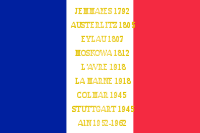1st Cuirassier Regiment (France)
| 1er Régiment de Cuirassiers | |
|---|---|
|
Flag of the regiment | |
| Active |
1635-1815 1816-1920 1939-1940 1943-1999 |
| Country | France |
| Branch | French Army |
| Type | Heavy cavalry |
| March | Le Regiment de Fer (Eng: The Iron Regiment) |
| Engagements |
Thirty Years' War War of the Spanish Succession French Revolutionary Wars Napoleonic Wars World War I World War II |
| Commanders | |
| Notable commanders | Henri de la Tour d'Auvergne, Vicomte de Turenne |
The 1st Cuirassier Regiment (French: 1er Régiment de Cuirassiers, 1er RC) was the oldest armoured regiment in the French Army, until it was amalgamated with 11th Cuirassiers Regiment. Today its traditions are carried on by the 1st Cuirassier Squadrons Group of the 1st-11th Cuirassier Regiment.
History
Origins
The regiment was a part of a small army raised by Bernhard of Saxe-Weimar in 1631 to help Gustavus Adolphus against the emperor during the Thirty Years' War. The regiment fought together with the Swedish Army at Breitenfeld, Rain and Lützen. With the death of Gustavus Adolphus and the disaster at Nördlingen the army of Bernhard of Saxe-Weimar entered French service on 26 October 1635. During this time the regiment was commanded by colonel Trefsky and carried his name: Trefsky regiment.
With Saxe-Weimers army France began involving itself directly into the war, instead of only subsidizing the Swedes. The Trefsky regiment takes part in the victories of Rheinfelden and Breisach, but with Saxe-Weimers death in the summer of 1639 the army loses its master. Some men want to return to Swedish service, but Guébriant, a future Marshal of France, persuades the army, with the help of strong pensions, to remain permanently in France.
The Regiment was renamed Colonel-General in 1657. In 1791 renamed to 1er Régiment de Cavalerie . In 1801 renamed to 1er Régiment de Cavalerie-Cuirassiers. In 1803 renamed to 1er Régiment de Cuirassiers. In 1814 renamed to Cuirassiers du Roi, but restored to 1er Régiment de Cuirassiers by Napoleon during the Hundred Days, was disbanded on 24 December 1815 at Loches after Napoleon's defeat. Re-raised in 1816 and named Cuirassiers de la Reine.
The regiment was a part of the great cavalry charge in the Battle of Eylau.
Regimental war record during the revolution and empire
(Battles and Combats)
- 1792: Jemmapes, Anderlecht, and Tienen.
- 1793: Maestricht, La Roer, Nerwinden, and Maubeuge.
- 1794: Mouscron, Pont-a-Chin, Roeselare, and the Capture of Mechelen.
- 1796: Rivoli and Tagliamento.
- 1799: Le Trebbia, La Secchia, Novi, and Genola.
- 1800: Mozambano.
- 1801: San-Massiano and Verone.
- 1805: Wertingen, Ulm, Hollabrunn, Raussnitz, and Austerlitz.
- 1806: Jena and the Capture of Lubeck.
- 1807: Hoff and Eylau.
- 1809: Eckmuhl, Ratisbonne, Essling, Wagram, Hollabrunn, and Znaim.
- 1812: La Moskowa and Winkowo.
- 1813: La Katzbach, Leipzig, Hanau, and the defense of Hamburg.
- 1814: La Chausee, Vauchamps, Bar-sur-Aube, Sezanne, and Valcourt.
- 1815: Ligny, Genappe, and Waterloo.
Restoration
When Louis XVIII returned to France again after the second abdication of Napoleon I, one of his first acts was to dissolve the entire French Army. The 1st Cuirassier Regiment was disbanded in Loches. According to General Suzanne its manpower went into the two new created Royal Guard cuirassier regiments and its depot was taken over by the 4th Cuirassier Regiment.
The Count of Béthune formed a new regiment on 27 September 1815. it was named the 1st Cuirassier Regiment or The Queen's Cuirassiers (French: Cuirassiers de la Reine). The regiment was organized with four squadrons and received its new standard on 28 August 1816 from the Duchess of Angoulme, in Compiegne.
Between 1816 and 1828, the regiment was successively garrisoned in Dijon (1819), Toul (1823), Sedan (1824), Nancy (1825), Joigny (1826), Vendôme (1827) and Tours (1828). When the 1830 revolution against the Bourbon monarchy broke out, the regiment was sent to Angers to ensure the maintenance of law and order, but did not have to actively intervene.
July Monarchy
The end of Bourbon rule in France also meant changes for the French Army. The regiment received a new commander: Colonel Count Ordener, on 5 August 1830. Several officers, who had been retired on half-pay since 1815 because of their Napoleonic sympathies, were able to return to the regiment. The regiment also lost the name: “Cuirassiers de la Reine” becoming simply the 1st Cuirassier Regiment.
Between 1830 and 1848, the regiment was garrisoned in various cities: Vendôme, Meaux (1830), Versailles (1831) and then Lille. The 1st Cuirassiers left the latter garrison to take part in the short campaign in Belgium in support of Belgian independence. When the regiment returned to France it was garrisoned in Compiegne (1832), Nancy (1833–1836), Paris (1837), Haguenau (1838–1842) and finally in Vesoul from 1843 to 1848.
During the French Revolution of 1848, the regiment was sent first to Mantes, then to Paris, to ensure law and order.
Honours
Battle Honours
- Jemmapes 1792
- Austerlitz 1805
- Eylau 1807
- La Moskowa 1812
- L'Avre 1918
- La Marne 1918
- Colmar 1945
- Stuttgart 1945
- AFN 1952–1962
Decorations
- Croix de guerre 1914-1918 with one palm and one star.
- Croix de guerre 1939-1945 with three palms.
External links
- (French) Website about the Regiment
